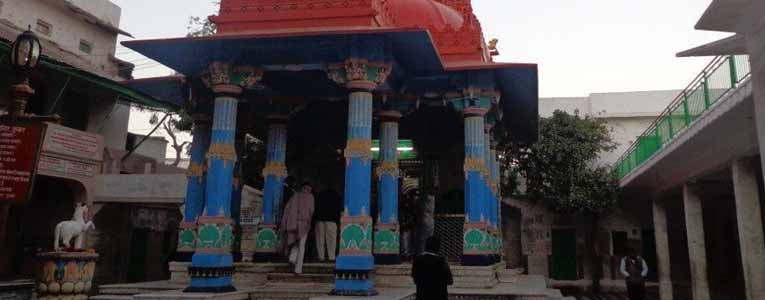


Jagatpita Brahma Mandir is a Hindu temple situated at Pushkar in the Indian state of Rajasthan, close to the sacred Pushkar Lake to which its legend has an indelible link. The temple is one of very few existing temples dedicated to the Hindu creator-god Brahma in India and remains the most prominent among them.
The temple structure dates to the 14th century, partly rebuilt later. The temple is made of marble and stone slabs. It has a distinct red pinnacle (shikhara) and a hamsa bird motif. The temple sanctum sanctorum holds the image of four-headed Brahma and his consort Gayatri. The temple is governed by the Sanyasi (ascetic) sect priesthood.[2] On Kartik Poornima, a festival dedicated to Brahma is held when large number of pilgrims visit the temple, after bathing in the sacred lake.
The temple, which is set on high plinth, is approached through a number of marble steps leading to an entrance gate archway, decorated with pillared canopies. The entry from the gate leads to a pillared outdoor hall (Mandapa) and then the sanctum sanctorum (Garbhagriha). The temple is built with stone slabs and blocks, joined together with molten lead. The red shikara (spire) of the temple and symbol of a hamsa (a swan or goose) - the mount of Brahma – are distinct features of the temple. The shikara is about 70 feet (21 m) in height. The hamsa motif decorates the main entry gate. Marble floor (in black and white checks) and walls inside the temple have been inlaid with hundreds of silver coins by devotees (with their names inscribed), as mark of offering to Brahma. There is a silver turtle in the mandap, that is displayed on the floor of the temple facing the Garbhagriha, which is also built in marble. The marble flooring has been replaced from time-to-time.
Brahma's central icon (murti) made of marble was deified in the garbhagriha 718 AD by Adi Shankara. The icon depicts Brahma, seated in a crossed leg position in the aspect of creation of the universe (the Vishvakarma form). The central image is called the chaumurti ("four-faced idol"). It is of life size with four hands and four faces, each oriented in a cardinal direction. The four arms hold the akshamala (rosary), the pustaka (book), the kurka (kusha grass) and the kamandalu (water pot). Brahma is riding on his mount, the hamsa. The four symbols held by Brahma in his arms (the rosary, Kamandalu, book and the sacrificial implement kusha grass) represent time, the causal waters from which the universe emerged, knowledge and the system of sacrifices to be adopted for sustenance of various life-forms in the universe. Gayatri's image sits along with Brahma's in centre to his left. Savatri alias Sarasvati sits to the right of Brahma, along with other deities of the Hindu pantheon. Images of the peacock, Sarasvati's mount, also decorate the temple walls. Images of the preserver-god Vishnu, life-sized dvarapalas (gate-keepers) and a gilded Garuda (eagle-man, mount of Vishnu) are also seen in the temple
One can easily reach Brahma Temple by taking regular Buses or by hiring taxis from anywhere in Rajasthan
In order to experience ultimate devotion towards Lord Brahma, schedule your trip to Pushkar between October to November. During this month, on the night of Kartik Poornima (full moon night of the Lunar month of Kartik as per Hindu calendar), a religious festival is organized in honor of the Lord. At such a religious accession, pilgrims in numbers of thousands take bath in the sacred lake of Pushkar. Several other rites at the Brahma temple also become part of the religious celebration.